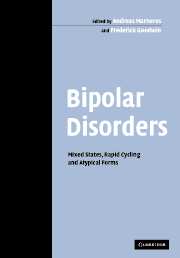Book contents
- Frontmatter
- Contents
- List of contributors
- Preface
- 1 Bipolar disorders beyond major depression and euphoric mania
- 2 Emerging concepts of mixed states: a longitudinal perspective
- 3 Rapid-cycling bipolar disorder
- 4 Bipolar I and bipolar II: a dichotomy?
- 5 Recurrent brief depression as an indicator of severe mood disorders
- 6 Atypical depression and its relation to bipolar spectrum
- 7 Agitated depression: spontaneous and induced
- 8 Schizoaffective mixed states
- 9 Acute and transient psychotic disorder: an atypical bipolar disorder?
- 10 Bipolar disorder in children and adolescents
- 11 Atypical features of bipolarity in old age
- 12 Comorbidity in mixed states and rapid-cycling forms of bipolar disorders
- 13 Challenges in the genetics of bipolar disorder
- 14 Biological aspects of rapid-cycling and mixed states
- 15 The treatment of bipolar mixed states
- 16 The use of atypical antipsychotic agents in the treatment of diagnostic subgroups of bipolar disorder: mixed and pure states, psychotic and non-psychotic
- 17 Investigational strategies: treatment of rapid cycling, mixed episodes, and atypical bipolar mood disorder
- Index
- References
10 - Bipolar disorder in children and adolescents
Published online by Cambridge University Press: 10 August 2009
- Frontmatter
- Contents
- List of contributors
- Preface
- 1 Bipolar disorders beyond major depression and euphoric mania
- 2 Emerging concepts of mixed states: a longitudinal perspective
- 3 Rapid-cycling bipolar disorder
- 4 Bipolar I and bipolar II: a dichotomy?
- 5 Recurrent brief depression as an indicator of severe mood disorders
- 6 Atypical depression and its relation to bipolar spectrum
- 7 Agitated depression: spontaneous and induced
- 8 Schizoaffective mixed states
- 9 Acute and transient psychotic disorder: an atypical bipolar disorder?
- 10 Bipolar disorder in children and adolescents
- 11 Atypical features of bipolarity in old age
- 12 Comorbidity in mixed states and rapid-cycling forms of bipolar disorders
- 13 Challenges in the genetics of bipolar disorder
- 14 Biological aspects of rapid-cycling and mixed states
- 15 The treatment of bipolar mixed states
- 16 The use of atypical antipsychotic agents in the treatment of diagnostic subgroups of bipolar disorder: mixed and pure states, psychotic and non-psychotic
- 17 Investigational strategies: treatment of rapid cycling, mixed episodes, and atypical bipolar mood disorder
- Index
- References
Summary
Introduction
There is no doubt that children and adolescents may experience classical Kraepelinian (1921) or Diagnostic and Statistical Manual of Mental Disorders (DSM)-type bipolar disorder (BP-I, II, mixed, rapid-cycling; American Psychiatric Association, 1994). However, as discussed in detail below, many BP children and adolescents have very short and frequent periods of mania, hypomania, or depression and, more controversially, some have continuous mood lability and irritability (Nottelman et al., 2001). Children and adolescents with BP disorder usually have poor psychosocial outcome, increased risk for suicide, substance abuse, and psychosis (Lewinsohn et al., 1995, 2000; Strober et al., 1995; Geller et al., 1998a, 1998b, 2000a, b, 2001; Birmaher, 2001), indicating the need for accurate diagnosis and prompt treatment of this illness.
Since the research on BP disorder in children and adolescents is in its earlier stages, below we present the extant literature following in most part the criteria described by Robins and Guze (1970) to validate a psychiatric disorder, including the presence of a reliable diagnosis that can be differentiated from other psychiatric disorders, specific course, family history, response to treatment, and biological characteristics. Because of their scarcity, no biological studies are presented in this chapter.
Prevalence
A large adolescent community study, using the Schedule for Affective Disorders and Schizophrenia for School-Aged Children (6–18) epidemiologic version (K-SADS) (Chambers et al., 1985), found that, similar to adult epidemiological studies, DSM-IV bipolar disorder was approximately 1% (Lewinsohn et al., 1995). However, most adolescents had BP-II (periods of major depression and hypomania) and cyclothymic disorders.
- Type
- Chapter
- Information
- Bipolar DisordersMixed States, Rapid Cycling and Atypical Forms, pp. 237 - 251Publisher: Cambridge University PressPrint publication year: 2005
References
- 1
- Cited by



